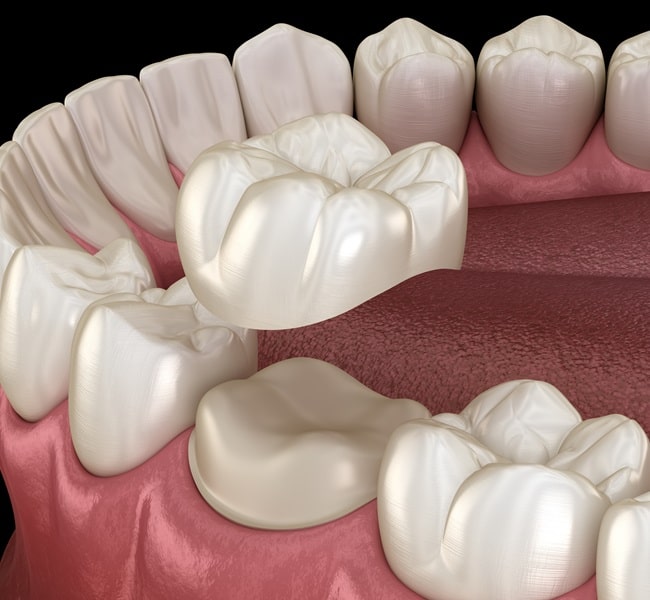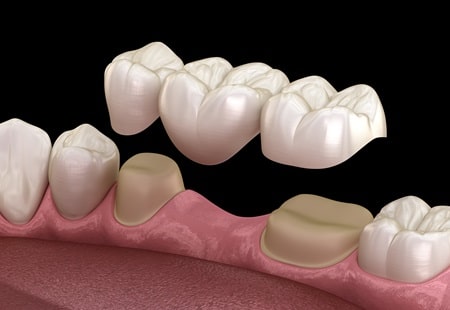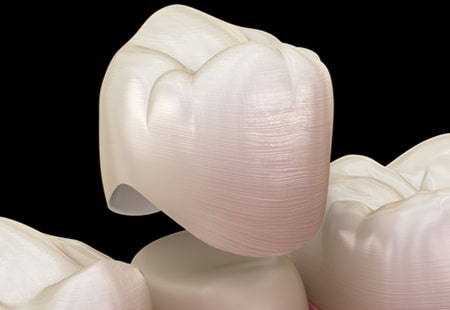Caulfeild Dental Centre
Dental Crowns and Bridges
Dental Crowns and Bridges in West Vancover
Are your missing teeth making you feel embarrassed about your smile? Maybe it’s not the missing teeth. Perhaps you secretly wish to repair cracked, broken, or discoloured teeth but don’t know your options. Even if it is as simple as eating without pain, obtaining a crown or bridge might provide you with the perfect choice for your smile.
Dental crowns are a restorative option for damaged teeth. There are many situations wherein a dentist may recommend this procedure, ranging from excessive tooth decay to tooth replacement. Conversely, dental bridges permanently replace missing teeth. They are a stable method of tooth replacement as they anchor onto natural, healthy teeth.
Why You Need Dental Bridges and Crowns
Dental bridges and crowns are two standard methods of restorative and cosmetic dentistry. They provide a solution to treat a myriad of dental issues, restoring the smile to its previous state. The benefits of these options go beyond just cosmetic reasons, as problems can arise if left untreated.
Dental crowns are used for teeth that:
- Have lost most of their form/strength
- Are too decayed
- Compromised natural tooth structure
- Damaged from trauma
- Used for a filling if there isn’t enough enamel to support it
- Cover discoloured or misshaped teeth
- Hide a dental implant
Dental crowns are also used for tooth replacement for partials or as part of bridgework.
On the other hand, dental bridges replace missing teeth. They prevent surrounding teeth from being worn down and don’t allow them to move within the mouth to fill the space.
At Caulfeild Dental, we will examine your tooth structure and determine the best method for your situation. We incorporate the latest technology in our examinations to ensure complete accuracy in our assessment.
Dental Bridges
Dental bridges restore the function and look of missing teeth. Bridges fill the gaps where missing teeth once were to prevent remaining teeth from becoming misaligned. It also helps you regain confidence in your smile, as no one will know you have work done. They feel completely natural as well.
Bridges are either non-removable or fixed prostheses designed to replace a missing tooth or teeth. Teeth on either side of the space anchor the bridge to restore functioning. The materials used are noble alloys, metal fused to porcelain, or porcelain. Porcelain is the most used as it blends naturally with surrounding teeth.
Four types of bridges are available: cantilever, traditional, implant-supported, and Maryland.
Getting a Dental Bridge at Caulfeild Dental in Vancouver
Our dental bridges involve shaving down teeth that are adjacent to the gap. Minor tooth decay will be cleaned, and we may build up a tooth when needed. A mould is created, consisting of the space between the two crowns and the gap. The mould goes to a dental lab, making the moulded piece that serves as a false tooth between them and a crown.
While waiting for the permanent bridge, a temporary one is provided and set using weak cement.
Once the permanent bridge is in, you will return for another appointment. We will place the bridge into the gap to ensure it fits properly. If it does, excess cement is removed, and the permanent bridge is set. We examine the final fit to ensure that the bite pattern isn’t affected and doesn’t interfere with other teeth.
Dental Crowns
Crowns are caps made from porcelain that are directly placed over a tooth. They are used to restore the function of a tooth and its appearance after a root canal. If there is advanced decay wherein large portions require removal, crowns can be used for restorative purposes.
Additional uses for a crown are to cover implants, attach bridges, prevent cracked teeth from worsening or help an existing filling from being dislocated to loosening. When applied to stained/discoloured teeth, they provide a cosmetic enhancement to the smile.
Getting a Dental Crown at Caulfeild Dental in Vancouver
At Caulfeild Dental, we will first examine and prepare the tooth. We take x-rays to explore the tooth’s roots receiving the crown and the surrounding bone. If extensive decay exists or there is injury/infection to the pulp, a root canal may be done before treatment.
Before making your crown, the surrounding tooth and the gum tissue will be numbed. Then, we reshape the tooth receiving the crown along its sides and chewing surface to make enough room for it. What is removed will depend on the crown type we use. However, if most of the tooth is missing from damage or decay, a filling material builds up the tooth to properly support the crown.
After the tooth is reshaped, a putty or paste is used to make an impression of the tooth. Sometimes, a digital scanner creates impressions. Impressions of upper and lower teeth are additionally made to ensure that your natural bite will remain unaffected.
Impressions go to a dental lab where they make the crown. In two to three weeks, they will be returned to our office. If comprised of porcelain, a shade that closely resembles the neighbouring teeth is selected. Our dentists will also create a temporary crown to protect and cover the prepared tooth while waiting for the crown.
At your second visit, we remove the temporary crown and examine the colour/fit of the permanent crown. If everything is fine, a local anesthetic is given to numb the area as we cement the new crown.
Aftercare for Your Dental Bridges and Crowns
There are certain factors that need to be taken into account after getting dental bridges or crowns.
For a temporary crown, you should follow these instructions:
- Avoid eating anything chewy or sticky, as it can pull off the crown.
- Do not eat hard foods which may break or dislodge your crown.
- Minimize eating on the side of the temporary crown. Instead, shift eating to the opposite side of your mouth.
- Slide dental floss when cleaning between teeth to avoid pulling off the crown,
Proper care for the permanent crown or bridge will determine how long it lasts. Like natural teeth, they will require daily brushing and flossing. Avoid biting hard objects, and don’t use your teeth to cut or break things open.
The recovery period is short for a dental bridge. Any trauma is generally resolved between each appointment.
Book Your Appointment in West Vancouver
At Caulfeild Dental, we use the latest technology in examining your teeth. Outdated equipment can provide inaccurate results. Therefore, we use the most up-to-date equipment to ensure that all of our assessments are entirely accurate and everything is noticed.
Our qualified dentists will provide you with the best options for crowns and bridges. We will help restore your teeth so you can smile with confidence again.
Located at the Caulfeild Village Shopping Center, we are close to the Bank of Montreal. We can be found between Headland Drive and Timberfeild Road.
Dental Crowns and Bridges FAQs
What are my options for replacing a missing tooth?
You can have a crown or a bridge to replace a missing tooth. Crowns tend to be used to replace one tooth, while bridges replace several.
What is the difference between crowns and bridges?
Crowns are created to appear like natural teeth. Bridges are a series of three-plus crowns attached. They replace one or more teeth that are missing.
General Inquiries
Looking for more information? Feel free to contact us and we will get back to you as soon as possible.
"*" indicates required fields
Accepting New Patients




